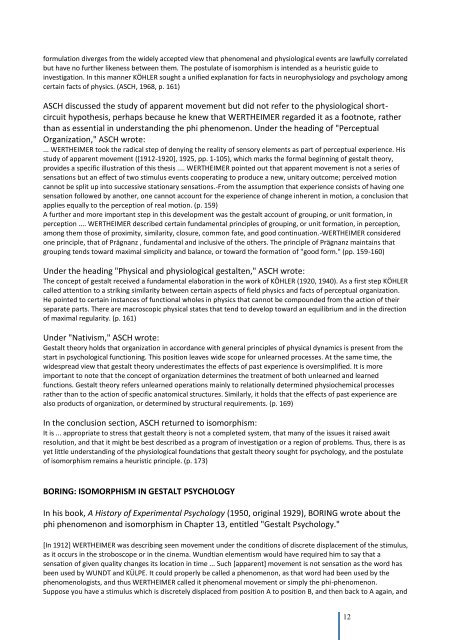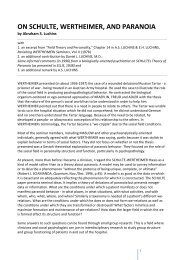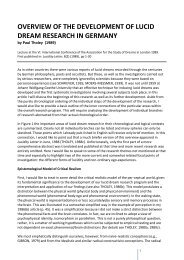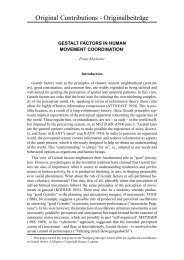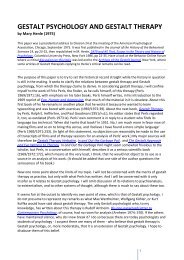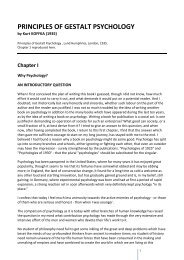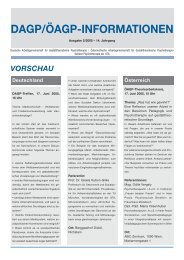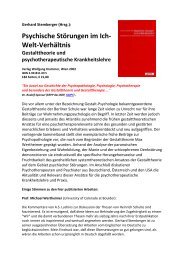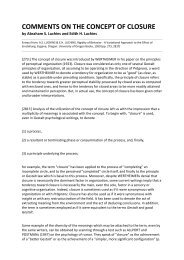<strong>for</strong>mulation diverges from the widely accepted view that phenomenal <strong>and</strong> physiological events are lawfully correlatedbut have no further likeness between them. The postulate of isomorphism is intended as a heuristic guide toinvestigation. In this manner KÖHLER sought a unified explanation <strong>for</strong> facts in neurophysiology <strong>and</strong> psychology amongcertain facts of physics. (ASCH, 1968, p. 161)ASCH discussed the study of apparent movement but did not refer to the physiological shortcircuithypothesis, perhaps because he knew that WERTHEIMER regarded it as a footnote, ratherthan as essential in underst<strong>and</strong>ing the phi phenomenon. Under the heading of "PerceptualOrganization," ASCH wrote:... WERTHEIMER took the radical step of denying the reality of sensory elements as part of perceptual experience. Hisstudy of apparent movement ([1912-1920], 1925, pp. 1-105), which marks the <strong>for</strong>mal beginning of gestalt theory,provides a specific illustration of this thesis .... WERTHEIMER pointed out that apparent movement is not a series ofsensations but an effect of two stimulus events cooperating to produce a new, unitary outcome; perceived motioncannot be split up into successive stationary sensations.-From the assumption that experience consists of having onesensation followed by another, one cannot account <strong>for</strong> the experience of change inherent in motion, a conclusion thatapplies equally to the perception of real motion. (p. 159)A further <strong>and</strong> more important step in this development was the gestalt account of grouping, or unit <strong>for</strong>mation, inperception .... WERTHEIMER described certain fundamental principles of grouping, or unit <strong>for</strong>mation, in perception,among them those of proximity, similarity, closure, common fate, <strong>and</strong> good continuation.-WERTHEIMER consideredone principle, that of Prägnanz , fundamental <strong>and</strong> inclusive of the others. The principle of Prägnanz maintains thatgrouping tends toward maximal simplicity <strong>and</strong> balance, or toward the <strong>for</strong>mation of "good <strong>for</strong>m." (pp. 159-160)Under the heading "Physical <strong>and</strong> physiological gestalten," ASCH wrote:The concept of gestalt received a fundamental elaboration in the work of KÖHLER (1920, 1940). As a first step KÖHLERcalled attention to a striking similarity between certain aspects of field physics <strong>and</strong> facts of perceptual organization.He pointed to certain instances of functional wholes in physics that cannot be compounded from the action of theirseparate parts. There are macroscopic physical states that tend to develop toward an equilibrium <strong>and</strong> in the directionof maximal regularity. (p. 161)Under "Nativism," ASCH wrote:<strong>Gestalt</strong> theory holds that organization in accordance with general principles of physical dynamics is present from thestart in psychological functioning. This position leaves wide scope <strong>for</strong> unlearned processes. At the same time, thewidespread view that gestalt theory underestimates the effects of past experience is oversimplified. It is moreimportant to note that the concept of organization determines the treatment of both unlearned <strong>and</strong> learnedfunctions. <strong>Gestalt</strong> theory refers unlearned operations mainly to relationally determined physiochemical processesrather than to the action of specific anatomical structures. Similarly, it holds that the effects of past experience arealso products of organization, or determined by structural requirements. (p. 169)In the conclusion section, ASCH returned to isomorphism:It is ... appropriate to stress that gestalt theory is not a completed system, that many of the issues it raised awaitresolution, <strong>and</strong> that it might be best described as a program of investigation or a region of problems. Thus, there is asyet little underst<strong>and</strong>ing of the physiological foundations that gestalt theory sought <strong>for</strong> psychology, <strong>and</strong> the postulateof isomorphism remains a heuristic principle. (p. 173)BORING: ISOMORPHISM IN GESTALT PSYCHOLOGYIn his book, A History of Experimental Psychology (1950, original 1929), BORING wrote about thephi phenomenon <strong>and</strong> isomorphism in Chapter 13, entitled "<strong>Gestalt</strong> Psychology."[In 1912] WERTHEIMER was describing seen movement under the conditions of discrete displacement of the stimulus,as it occurs in the stroboscope or in the cinema. Wundtian elementism would have required him to say that asensation of given quality changes <strong>its</strong> location in time ... Such [apparent] movement is not sensation as the word hasbeen used by WUNDT <strong>and</strong> KÜLPE. It could properly be called a phenomenon, as that word had been used by thephenomenologists, <strong>and</strong> thus WERTHEIMER called it phenomenal movement or simply the phi-phenomenon.Suppose you have a stimulus which is discretely displaced from position A to position B, <strong>and</strong> then back to A again, <strong>and</strong>12
to B again ... If the time-interval between the exposures at the two positions is long, you see simply discretedisplacement, no movement. If the time-interval is shortened, you begin to see some movement at A or at B or both.If it is still further shortened, you come to the optimal rate at which perfect movement back <strong>and</strong> <strong>for</strong>th is perceivedbetween A <strong>and</strong> B <strong>and</strong> in which the phi-phenomenon marks the movement ... Such phi is a visual perception, localizedin space, with given extension ... Phi is, moreover, an emergent. It pertains to a whole psychophysical situation <strong>and</strong>not to any of the separate factors that enter into it. In that it is as much a founded characteristic as is shape, melody,or any other <strong>Gestalt</strong>.Because <strong>Gestalt</strong> psychology tends to deal with wholes it frequently finds <strong>its</strong>elf concerned with fields <strong>and</strong> field theory.A field is a dynamic whole, a system in which an alteration of any part affects all the other parts .... Becauseperception seems often to follow laws of physical dynamics, KÖHLER has supposed that there are neural brain fieldswhich underlie <strong>and</strong> account <strong>for</strong> the dynamics inherent in the phenomenon of perception. KOFFKA has supposed thatyou must underst<strong>and</strong> human action in terms of a behavioural field which includes, not the stimuli <strong>and</strong> the physicalenvironment, but the outer world <strong>and</strong> <strong>its</strong> objects as perceived <strong>and</strong> conceived by the actor. (1950, pp. 590-591)... There is much more to be understood about <strong>Gestalt</strong> psychology than that it deals with wholes <strong>and</strong> phenomena.Usually it works in terms of field theory, as we have noted. The important <strong>Gestalt</strong> psychologists have accepted aspecial theory of relation between experienced phenomena <strong>and</strong> the underlying brain processes, the theory calledisomorphism, <strong>and</strong> to that we shall return. (p. 593)Returning to the isomorphism concept in Chapter 25, "Brain Function," BORING wrote:In the twentieth century the <strong>Gestalt</strong> psychologists have argued <strong>for</strong> isomorphism. WERTHEIMER suggested this relation<strong>for</strong> seen movement in 1912, but KÖHLER has been <strong>its</strong> most effective supporter since 1920 .... Isomorphism is notprojection but it implies it. The <strong>Gestalt</strong> theory is that a spatial pattern of perception is isomorphic with the spatialpattern of the underlying excitation in the brain. Isomorphic means corresponding topologically, but nottopographically. Shapes are not preserved, but orders are. In-betweeness is preserved .... It seems pretty clear thatWERTHEIMER <strong>and</strong> KÖHLER got this view, not from the results of research, but from the atmosphere of the times,perhaps from G.E. MÜLLER's axioms, which, like all axioms, ask <strong>for</strong> acceptance without proof. [Does history supportBORING s conjecture? Was this conception of isomorphism not the result of research?] On the other h<strong>and</strong>, the beliefin both visual <strong>and</strong> somesthetic cortical projection was growing <strong>and</strong> the two theories, projection <strong>and</strong> isomorphism,support each other. The stimulus-object <strong>and</strong> the peripheral excitation are isomorphic. The perception <strong>and</strong> thestimulus-object are isomorphic. If perception <strong>and</strong> the cortical excitation are isomorphic, then the cortical <strong>and</strong>peripheral excitation must also be isomorphic, since patterns isomorphic with the same pattern would be isomorphicwith each other.It is true that WERTHEIMER went out of his way to object to isomorphism between peripheral excitation <strong>and</strong>perception because he had in mind the many instances, like the perceptual constancies, where the correspondence isnot exact topographically; but these arguments deal with gross approximations. There is no doubt that the reason thatKÖHLER's contention seemed so plausible was due in part to the growth of the belief in projection. For the samereason some of KÖHLER's more recent experimental demonstrations of the isomorphic relation between perception<strong>and</strong> brain excitations are consistent with the theory of central projection or at least with central isomorphicreduplication if projection is not the physiological means which the organism employs. (Ibid., pp. 681-682)The index to BORING's 1950 book listed projection, discussed on pages 680-682, only in relation toisomorphism. BORING's statements raise interesting questions about the relationship. Doesisomorphism imply projection? Do projection <strong>and</strong> isomorphism support each other? Also ofparticular interest to us are BORING's remarks that WERTHEIMER went out of his way to object toisomorphism because he had in mind instances such as the perceptual "constancies," where thecorrespondence is not exact topographically; un<strong>for</strong>tunately, references were not cited.For more detailed discussion of perception, BORING referred the reader to his 1942 book,Sensations <strong>and</strong> Perceptions in the History of Experimental Psychology. In Chapter 2, "Physiology ofSensations," the section entitled "Projection," included the following:The receptor-fields of the sense-organs are projected upon the central nervous system in the sense that the afferentfibers lead to the central system. Indirectly by way of synaptic connections in nuclei, the tracts of all five sensesestablish in man connection with the cerebral cortex, although they also make other connections at subcortical reflexlevels which do not involve the cortex. Thus neural anatomy has come to support Johannes MÜLLER's theory ofspecific nerve energies, which eventually became .... a projection theory of sensory quality. Sight is not hearingbecause the optic fibers are projected upon the occipital lobes <strong>and</strong> the auditory upon the temporal lobes. If you couldcross-connect the optic <strong>and</strong> auditory nerves, you could, du BOIS-REYMOND imagined, see tones <strong>and</strong> hear colors. (p.78). [fn 2]13


